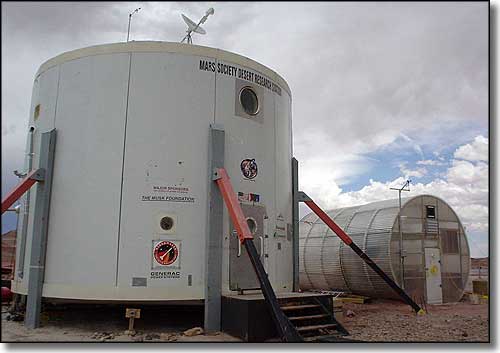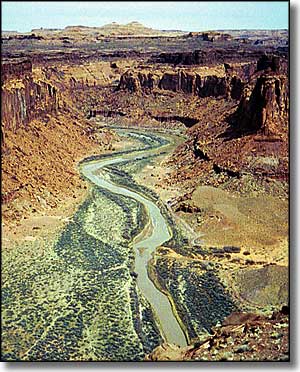
Hanksville, Utah

The Mars Society Desert Research Station: the Habitat and the Greenhab

Hanksville was first settled as "Graves Valley" (named for John Graves, a member of the Powell Expedition) on the Dirty Devil River, just below the confluence of the Fremont River and Muddy Creek in 1882. In 1885, the settlement formally changed its name to Hanksville, after Ebenezer Hanks, leader of the Mormon pioneers who established the settlement.
Hanksville began as an agricultural settlement but mining took on a role early on and these days, tourism plays a big part in the local economy, too. Hanksville is at a crossroads for people coming from and going to Capitol Reef National Park, Goblin Valley State Park, the Henry Mountains, Lake Powell and the San Rafael Swell.
Southeast of Hanksville in the canyons along the Dirty Devil River is Robber's Roost, a famous outlaw hideout in the late 1800's that was often used by Butch Cassidy and the Wild Bunch. Those outlaws often came into Hanksville for their supplies. Hanksville was also a supply center for many of the uranium prospectors who were scouring the deserts of the Colorado Plateau in the years after World War II. Nearly all of those mines are abandoned now, but the nearby Hanksville-Burpee Quarry has recently become a prolific producer of dinosaur fossils and other remains.
7 miles northwest of Hanksville is the Mars Desert Research Station, a location that was chosen by the Mars Society for developing field tactics based on working in spacesuits, to test habitat designs and features, and to assess crew selection protocols. While the area is obviously much warmer than the surface of Mars, the terrain and its appearance are very much like the surface of Mars. Crew and equipment simulations occur only in the winter months.
Latitude: 38.373°N
Longitude: 110.714°W
Incorporated: 1999
Elevation: 4,291'
Education:
High School or Higher: 87.9%
Bachelor's Degree or Higher: 17.9%
Graduate or Professional Degree: 2.9%
2011 Cost of Living Index for Hanksville: 84.0
Median Resident Age: 34.0 Years
Estimated Median Household Income: $40,650
Estimated Median Home Value: $152,700
Population Density: 0.2 People per Square Mile
Major Industries:
Lodging & Food Services, Agriculture, Construction, Arts, Entertainment & Recreation, Government, Educational Services, Social Services
Unemployed (March 2011): 13.0%
Population Demographics: 2010
| Total Population | 219 |
| Males | 114 |
| Females | 105 |
| Population by Age | |
| Under 18 | 72 |
| 18 & over | 147 |
| 20-24 | 8 |
| 25-34 | 19 |
| 35-49 | 37 |
| 50-64 | 45 |
| 65 & over | 29 |
| Population by Ethnicity | |
| Hispanic or Latino | 2 |
| Non Hispanic or Latino | 217 |
| Population by Race | |
| White | 215 |
| African-American | 0 |
| Asian | 1 |
| Native American | 0 |
| Hawaiian or Pacific Islander | 0 |
| Other | 0 |
| Two or more | 3 |
